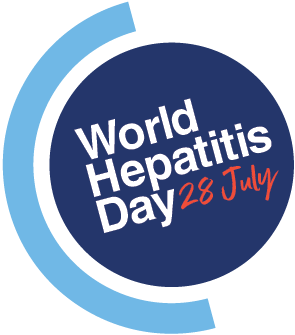Medscape CME Activity
Medscape, LLC is pleased to provide online continuing medical education (CME) for selected journal articles, allowing clinicians the opportunity to earn CME credit. In support of improving patient care, these activities have been planned and implemented by Medscape, LLC and Emerging Infectious Diseases. Medscape, LLC is jointly accredited by the Accreditation Council for Continuing Medical Education (ACCME), the Accreditation Council for Pharmacy Education (ACPE), and the American Nurses Credentialing Center (ANCC), to provide continuing education for the healthcare team.
CME credit is available for one year after publication.
Volume 26—2020
Volume 26, Number 12—December 2020
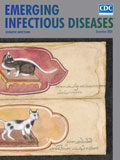
In 2015, an outbreak of presumed waterborne toxoplasmosis occurred in Gouveia, Brazil. We conducted a 3-year prospective study on a cohort of 52 patients from this outbreak, collected clinical and multimodal imaging findings, and determined risk factors for ocular involvement. At baseline examination, 12 (23%) patients had retinochoroiditis; 4 patients had bilateral and 2 had macular lesions. Multimodal imaging revealed 2 distinct retinochoroiditis patterns: necrotizing focal retinochoroiditis and punctate retinochoroiditis. Older age, worse visual acuity, self-reported recent reduction of visual acuity, and presence of floaters were associated with retinochoroiditis. Among patients, persons >40 years of age had 5 times the risk for ocular involvement. Five patients had recurrences during follow-up, a rate of 22% per person-year. Recurrences were associated with binocular involvement. Two patients had late ocular involvement that occurred >34 months after initial diagnosis. Patients with acquired toxoplasmosis should have long-term ophthalmic follow-up, regardless of initial ocular involvement.
| EID | Brandão-de-Resende C, Santos H, Rojas Lagos A, Lara C, Arruda J, Marino A, et al. Clinical and Multimodal Imaging Findings and Risk Factors for Ocular Involvement in a Presumed Waterborne Toxoplasmosis Outbreak, Brazil. Emerg Infect Dis. 2020;26(12):2922-2932. https://doi.org/10.3201/eid2612.200227 |
|---|---|
| AMA | Brandão-de-Resende C, Santos H, Rojas Lagos A, et al. Clinical and Multimodal Imaging Findings and Risk Factors for Ocular Involvement in a Presumed Waterborne Toxoplasmosis Outbreak, Brazil. Emerging Infectious Diseases. 2020;26(12):2922-2932. doi:10.3201/eid2612.200227. |
| APA | Brandão-de-Resende, C., Santos, H., Rojas Lagos, A., Lara, C., Arruda, J., Marino, A....Vasconcelos-Santos, D. (2020). Clinical and Multimodal Imaging Findings and Risk Factors for Ocular Involvement in a Presumed Waterborne Toxoplasmosis Outbreak, Brazil. Emerging Infectious Diseases, 26(12), 2922-2932. https://doi.org/10.3201/eid2612.200227. |
HIV-infected children and adolescents are at increased risk for tuberculosis (TB). Antiretroviral therapy (ART) reduces TB risk in HIV-infected adults, but its effectiveness in HIV-infected children and adolescents is unknown. We analyzed data from 7 integrated pediatric HIV/TB centers in 6 countries in sub-Saharan Africa. We used a Bayesian mixed-effect model to assess association between ART and TB prevalence and used adaptive lasso regression to analyze risk factors for adverse TB outcomes. The study period encompassed 57,525 patient-years and 1,160 TB cases (2,017 cases/100,000 patient-years). Every 10% increase in ART uptake resulted in a 2.33% reduction in TB prevalence. Favorable TB outcomes were associated with increased time in care and early ART initiation, whereas severe immunosuppression was associated with death. These findings support integrated HIV/TB services for HIV-infected children and adults and demonstrate the association of ART uptake with decreased TB incidence in high HIV/TB settings.
Volume 26, Number 11—November 2020
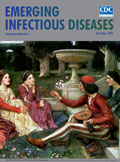
Livestock-associated methicillin-resistant Staphylococcus aureus (LA-MRSA) can acquire phage-encoded immune modulators, such as the immune evasion cluster (IEC), which protects bacteria from components of the human innate immune system, and the enzyme TarP, which protects against antibody-mediated immune recognition. We used whole-genome sequencing and epidemiologic investigations to study the effects of IEC- and tarP-harboring phages on household transmission of LA-MRSA in North Denmark Region during 2004–2011. We reviewed information about all patients throughout Denmark who experienced LA-MRSA infection during 2007–2018 to determine whether IEC is associated with increased spread into the general population. Horizontal acquisition of IEC in the human host was associated with increased household transmission of LA-MRSA and spillover into the community and healthcare settings, whereas we found no evidence to suggest that IEC-positive LA-MRSA isolates have become self-sustainable in the general population. By contrast, TarP did not seem to influence household transmission of LA-MRSA.
| EID | Sieber RN, Urth TR, Petersen A, Møller CH, Price LB, Skov RL, et al. Phage-Mediated Immune Evasion and Transmission of Livestock-Associated Methicillin-Resistant Staphylococcus aureus in Humans. Emerg Infect Dis. 2020;26(11):2578-2585. https://doi.org/10.3201/eid2611.201442 |
|---|---|
| AMA | Sieber RN, Urth TR, Petersen A, et al. Phage-Mediated Immune Evasion and Transmission of Livestock-Associated Methicillin-Resistant Staphylococcus aureus in Humans. Emerging Infectious Diseases. 2020;26(11):2578-2585. doi:10.3201/eid2611.201442. |
| APA | Sieber, R. N., Urth, T. R., Petersen, A., Møller, C. H., Price, L. B., Skov, R. L....Larsen, J. (2020). Phage-Mediated Immune Evasion and Transmission of Livestock-Associated Methicillin-Resistant Staphylococcus aureus in Humans. Emerging Infectious Diseases, 26(11), 2578-2585. https://doi.org/10.3201/eid2611.201442. |
Volume 26, Number 10—October 2020
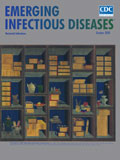
Healthcare-associated Legionnaires’ disease (HCA LD) can cause nosocomial outbreaks with high death rates. We compared community-acquired LD cases with HCA LD cases in Europe during 2008−2017 using data from The European Surveillance System. A total of 29 countries reported 40,411 community-acquired and 4,315 HCA LD cases. Of the HCA LD cases, 2,937 (68.1%) were hospital-acquired and 1,378 (31.9%) were linked to other healthcare facilities. The odds of having HCA LD were higher for women, children and persons <20 years of age, and persons >60 years of age. Out of the cases caused by Legionella pneumophila with a known serotype, community-acquired LD was more likely to be caused by L. pneumophila serogroup 1 (92.3%) than was HCA LD (85.1%). HCA LD patients were more likely to die. HCA LD is associated with specific patient demographics, causative strains, and outcomes. Healthcare facilities should consider these characteristics when designing HCA LD prevention strategies.
| EID | Beauté J, Plachouras D, Sandin S, Giesecke J, Sparén P. Healthcare-Associated Legionnaires’ Disease, Europe, 2008−2017. Emerg Infect Dis. 2020;26(10):2309-2318. https://doi.org/10.3201/eid2610.181889 |
|---|---|
| AMA | Beauté J, Plachouras D, Sandin S, et al. Healthcare-Associated Legionnaires’ Disease, Europe, 2008−2017. Emerging Infectious Diseases. 2020;26(10):2309-2318. doi:10.3201/eid2610.181889. |
| APA | Beauté, J., Plachouras, D., Sandin, S., Giesecke, J., & Sparén, P. (2020). Healthcare-Associated Legionnaires’ Disease, Europe, 2008−2017. Emerging Infectious Diseases, 26(10), 2309-2318. https://doi.org/10.3201/eid2610.181889. |
Shiga toxin–producing Escherichia coli (STEC) cause substantial and costly illnesses. Leafy greens are the second most common source of foodborne STEC O157 outbreaks. We examined STEC outbreaks linked to leafy greens during 2009–2018 in the United States and Canada. We identified 40 outbreaks, 1,212 illnesses, 77 cases of hemolytic uremic syndrome, and 8 deaths. More outbreaks were linked to romaine lettuce (54%) than to any other type of leafy green. More outbreaks occurred in the fall (45%) and spring (28%) than in other seasons. Barriers in epidemiologic and traceback investigations complicated identification of the ultimate outbreak source. Research on the seasonality of leafy green outbreaks and vulnerability to STEC contamination and bacterial survival dynamics by leafy green type are warranted. Improvements in traceability of leafy greens are also needed. Federal and state health partners, researchers, the leafy green industry, and retailers can work together on interventions to reduce STEC contamination.
| EID | Marshall KE, Hexemer A, Seelman SL, Fatica MK, Blessington T, Hajmeer M, et al. Lessons Learned from a Decade of Investigations of Shiga Toxin–Producing Escherichia coli Outbreaks Linked to Leafy Greens, United States and Canada. Emerg Infect Dis. 2020;26(10):2319-2328. https://doi.org/10.3201/eid2610.191418 |
|---|---|
| AMA | Marshall KE, Hexemer A, Seelman SL, et al. Lessons Learned from a Decade of Investigations of Shiga Toxin–Producing Escherichia coli Outbreaks Linked to Leafy Greens, United States and Canada. Emerging Infectious Diseases. 2020;26(10):2319-2328. doi:10.3201/eid2610.191418. |
| APA | Marshall, K. E., Hexemer, A., Seelman, S. L., Fatica, M. K., Blessington, T., Hajmeer, M....Gieraltowski, L. (2020). Lessons Learned from a Decade of Investigations of Shiga Toxin–Producing Escherichia coli Outbreaks Linked to Leafy Greens, United States and Canada. Emerging Infectious Diseases, 26(10), 2319-2328. https://doi.org/10.3201/eid2610.191418. |
Volume 26, Number 9—September 2020
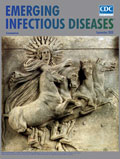
Nine new human invasive infections caused by the keratinophilic fungi Nannizziopsis obscura have been reported in France since 2004. The patients had variable clinical manifestations, had frequent dissemination, were mainly T-cell immunocompromised, and all originated from sub-Saharan West Africa. Before collection of the isolates, the etiologies of these infections were often misidentified, underscoring the extent of microscopic and cultural polymorphisms. All isolates but 1 had low MICs for the 8 antifungal drugs tested. When treated, patients received mainly azole therapy. Two of 7 patients with a known outcome died. We performed multilocus sequence analysis of N. obscura clinical strains and several strains of Nannizziopsis spp. isolated from reptiles. The human strains were clearly differentiated from the animal strains. N. obscura might be endemic to West Africa and responsible for undetected infections, which might become reactivated when immunosuppression occurs. N. obscura infection is probably underestimated because only sequencing enables proper identification.
| EID | Garcia-Hermoso D, Hamane S, Fekkar A, Jabet A, Denis B, Siguier M, et al. Invasive Infections with Nannizziopsis obscura Species Complex in 9 Patients from West Africa, France, 2004–2020. Emerg Infect Dis. 2020;26(9):2022-2030. https://doi.org/10.3201/eid2609.200276 |
|---|---|
| AMA | Garcia-Hermoso D, Hamane S, Fekkar A, et al. Invasive Infections with Nannizziopsis obscura Species Complex in 9 Patients from West Africa, France, 2004–2020. Emerging Infectious Diseases. 2020;26(9):2022-2030. doi:10.3201/eid2609.200276. |
| APA | Garcia-Hermoso, D., Hamane, S., Fekkar, A., Jabet, A., Denis, B., Siguier, M....Bretagne, S. (2020). Invasive Infections with Nannizziopsis obscura Species Complex in 9 Patients from West Africa, France, 2004–2020. Emerging Infectious Diseases, 26(9), 2022-2030. https://doi.org/10.3201/eid2609.200276. |
Q fever osteoarticular infection in children is an underestimated disease. We report 3 cases of Q fever osteomyelitis in children and review all cases reported in the literature through March 2018. A high index of suspicion is encouraged in cases of an unusual manifestation, prolonged course, relapsing symptoms, nonresolving or slowly resolving osteomyelitis, culture-negative osteomyelitis, or bone histopathology demonstrating granulomatous changes. Urban residence or lack of direct exposure to animals does not rule out infection. Diagnosis usually requires use of newer diagnostic modalities. Optimal antimicrobial therapy has not been well established; some case-patients may improve spontaneously or during treatment with a β-lactam. The etiology of treatment failure and relapse is not well understood, and tools for follow-up are lacking. Clinicians should be aware of these infections in children to guide optimal treatment, including choice of antimicrobial drugs, duration of therapy, and methods of monitoring response to treatment..
| EID | Dabaja-Younis H, Meir M, Ilivizki A, Militianu D, Eidelman M, Kassis I, et al. Q Fever Osteoarticular Infection in Children. Emerg Infect Dis. 2020;26(9):2039-2045. https://doi.org/10.3201/eid2609.191360 |
|---|---|
| AMA | Dabaja-Younis H, Meir M, Ilivizki A, et al. Q Fever Osteoarticular Infection in Children. Emerging Infectious Diseases. 2020;26(9):2039-2045. doi:10.3201/eid2609.191360. |
| APA | Dabaja-Younis, H., Meir, M., Ilivizki, A., Militianu, D., Eidelman, M., Kassis, I....Shachor-Meyouhas, Y. (2020). Q Fever Osteoarticular Infection in Children. Emerging Infectious Diseases, 26(9), 2039-2045. https://doi.org/10.3201/eid2609.191360. |
Volume 26, Number 8—August 2020
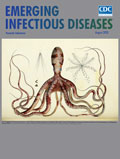
We investigated sporadic Creutzfeldt-Jakob disease (sCJD) among physicians in Germany by analyzing occupational information of patients with sCJD recorded by the German CJD Surveillance Unit (1993–2005; 1,250 patients, of whom 4 [0.32%] were physicians) and the National Reference Center for Human Spongiform Encephalopathies (2006–2016; 1,491 patients, of whom 13 [0.87%] were physicians). Among the physicians, we did not identify any neurologists, neurosurgeons, psychiatrists, or pathologists. A cumulative sum test showed an increase in reported physicians over time. Data for 2017–2018 indicated an increased rate of physicians among all notified sCJD cases (5/239 [2.1%]) when we used the total population of Germany as control group. Our data suggest the possibility of an increased risk for sCJD among physicians in Germany. However, we can only speculate about the reasons, and larger multinational studies are needed to replicate the finding and to clarify whether this finding is a general or a country-specific phenomenon.
| EID | Hermann P, Treig J, Unkel S, Goebel S, Bunck T, Jünemann M, et al. Sporadic Creutzfeldt-Jakob Disease among Physicians, Germany, 1993–2018. Emerg Infect Dis. 2020;26(8):1710-1719. https://doi.org/10.3201/eid2608.191159 |
|---|---|
| AMA | Hermann P, Treig J, Unkel S, et al. Sporadic Creutzfeldt-Jakob Disease among Physicians, Germany, 1993–2018. Emerging Infectious Diseases. 2020;26(8):1710-1719. doi:10.3201/eid2608.191159. |
| APA | Hermann, P., Treig, J., Unkel, S., Goebel, S., Bunck, T., Jünemann, M....Zerr, I. (2020). Sporadic Creutzfeldt-Jakob Disease among Physicians, Germany, 1993–2018. Emerging Infectious Diseases, 26(8), 1710-1719. https://doi.org/10.3201/eid2608.191159. |
US guidelines have recommended testing children emigrating from high tuberculosis-incidence countries with interferon-gamma release assays (IGRAs) or tuberculin skin tests (TSTs). We describe the Harris County (Texas) Public Health Refugee Health Screening Program’s testing results during 2010–2015 for children <18 years of age: 5,990 were evaluated, and 5,870 (98%) were tested. Overall, 364 (6.2%) children had >1 positive test: 143/1,842 (7.8%) were tested with TST alone, 129/3,730 (3.5%) with IGRA alone, and 92/298 (30.9%) with both TST and IGRA. Region of origin and younger age were associated with positive TST or IGRA results. All children were more likely to have positive results for TST than for IGRA (OR 2.92, 95% CI 2.37–3.59). Discordant test results were common (20%) and most often were TST+/IGRA– (95.0%), likely because of bacillus Calmette-Guérin vaccination. Finding fewer false positives supports the 2018 change in US immigration guidelines that recommends using IGRAs for recently immigrated children.
| EID | Lamb GS, Cruz AT, Camp EA, Javier M, Montour J, Piper T, et al. Tuberculosis in Internationally Displaced Children Resettling in Harris County, Texas, USA, 2010–2015. Emerg Infect Dis. 2020;26(8):1686-1694. https://doi.org/10.3201/eid2608.190793 |
|---|---|
| AMA | Lamb GS, Cruz AT, Camp EA, et al. Tuberculosis in Internationally Displaced Children Resettling in Harris County, Texas, USA, 2010–2015. Emerging Infectious Diseases. 2020;26(8):1686-1694. doi:10.3201/eid2608.190793. |
| APA | Lamb, G. S., Cruz, A. T., Camp, E. A., Javier, M., Montour, J., Piper, T....Starke, J. R. (2020). Tuberculosis in Internationally Displaced Children Resettling in Harris County, Texas, USA, 2010–2015. Emerging Infectious Diseases, 26(8), 1686-1694. https://doi.org/10.3201/eid2608.190793. |
Volume 26, Number 7—July 2020
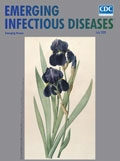
Orientia tsutsugamushi, spotted fever group rickettsioses, and typhus group rickettsioses (TGR) are reemerging causes of acute febrile illness (AFI) in Southeast Asia. To further delineate extent, we enrolled patients >4 weeks of age with nonmalarial AFI in Sabah, Malaysia, during 2013–2015. We confirmed rickettsioses (past or acute, IgG titer >160) in 126/354 (36%) patients. We confirmed acute rickettsioses (paired 4-fold IgG titer rise to >160) in 38/145 (26%) patients: 23 O. tsutsugamushi, 9 spotted fever group, 4 TGR, 1 O. tsutsugamushi/spotted fever group, and 1 O. tsutsugamushi/TGR. PCR results were positive in 11/319 (3%) patients. Confirmed rickettsioses were more common in male adults; agricultural/plantation work and recent forest exposure were risk factors. Dizziness and acute hearing loss but not eschars were reported more often with acute rickettsioses. Only 2 patients were treated with doxycycline. Acute rickettsioses are common (>26%), underrecognized, and untreated etiologies of AFI in East Malaysia; empirical doxycycline treatment should be considered.
| EID | Grigg MJ, William T, Clemens EG, Patel K, Chandna A, Wilkes CS, et al. Rickettsioses as Major Etiologies of Unrecognized Acute Febrile Illness, Sabah, East Malaysia. Emerg Infect Dis. 2020;26(7):1409-1419. https://doi.org/10.3201/eid2607.191722 |
|---|---|
| AMA | Grigg MJ, William T, Clemens EG, et al. Rickettsioses as Major Etiologies of Unrecognized Acute Febrile Illness, Sabah, East Malaysia. Emerging Infectious Diseases. 2020;26(7):1409-1419. doi:10.3201/eid2607.191722. |
| APA | Grigg, M. J., William, T., Clemens, E. G., Patel, K., Chandna, A., Wilkes, C. S....Reller, M. E. (2020). Rickettsioses as Major Etiologies of Unrecognized Acute Febrile Illness, Sabah, East Malaysia. Emerging Infectious Diseases, 26(7), 1409-1419. https://doi.org/10.3201/eid2607.191722. |
Atypical manifestations that can be severe and difficult to diagnosis develop in 5%–20% of patients with cat-scratch disease. To clarify the epidemiology of atypical cat-scratch disease in the United States, we analyzed data from the 2005–2014 MarketScan national health insurance claims databases by using the International Classification of Diseases, 9th Revision, Clinical Modification, codes for cat-scratch disease and selected atypical manifestations: retinitis/neuroretinitis, conjunctivitis, neuritis, encephalitis, hepatosplenic disease, osteomyelitis, erythema nodosum, and endocarditis. Atypical cat-scratch disease accounted for 1.5% of all cases, resulting in an average annual incidence of 0.7 cases/100,000 population. Atypical cat-scratch disease was associated with increased risk for hospitalization (risk ratios 8.77, 95% CI 6.56–11.72) and occurred most often in female patients 10–14 years of age. Ocular (48.7%), hepatosplenic (24.6%), and neurologic (13.8%) manifestations were most common among patients. A more comprehensive understanding of atypical cat-scratch disease can improve patient diagnosis and potentially elucidate pathophysiology of the disease.
| EID | Nawrocki CC, Max RJ, Marzec NS, Nelson CA. Atypical Manifestations of Cat-Scratch Disease, United States, 2005–2014. Emerg Infect Dis. 2020;26(7):1438-1446. https://doi.org/10.3201/eid2607.200034 |
|---|---|
| AMA | Nawrocki CC, Max RJ, Marzec NS, et al. Atypical Manifestations of Cat-Scratch Disease, United States, 2005–2014. Emerging Infectious Diseases. 2020;26(7):1438-1446. doi:10.3201/eid2607.200034. |
| APA | Nawrocki, C. C., Max, R. J., Marzec, N. S., & Nelson, C. A. (2020). Atypical Manifestations of Cat-Scratch Disease, United States, 2005–2014. Emerging Infectious Diseases, 26(7), 1438-1446. https://doi.org/10.3201/eid2607.200034. |
Volume 26, Number 6—June 2020
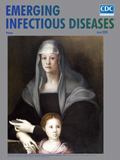
Data are limited on the incidence and management of streptococcal toxic shock syndrome (TSS) and nonstreptococcal TSS in children. We aimed to define the clinical patterns of TSS at Nationwide Children’s Hospital in Ohio as they relate to published criteria, diagnostic decisions, and treatment options. Through retrospective chart reviews, we identified 58 patients with TSS (27 streptococcal, 31 nonstreptococcal) during January 2010–September 2017. We observed clinical and laboratory findings that are not part of TSS criteria, such as pyuria in streptococcal TSS (50% of patients) and pulmonary involvement (85%) and coagulopathy (92%) in nonstreptococcal TSS patients. Recommended treatment with clindamycin and intravenous immunoglobulin was delayed in streptococcal TSS patients without rash (3.37 days vs. 0.87 days in patients with rash), leading to prolonged hospitalization and complications. Incorporation of additional TSS signs and symptoms would be helpful in TSS diagnosis and management.
| EID | Cook A, Janse S, Watson JR, Erdem G. Manifestations of Toxic Shock Syndrome in Children, Columbus, Ohio, USA, 2010–2017. Emerg Infect Dis. 2020;26(6):1077-1083. https://doi.org/10.3201/eid2606.190783 |
|---|---|
| AMA | Cook A, Janse S, Watson JR, et al. Manifestations of Toxic Shock Syndrome in Children, Columbus, Ohio, USA, 2010–2017. Emerging Infectious Diseases. 2020;26(6):1077-1083. doi:10.3201/eid2606.190783. |
| APA | Cook, A., Janse, S., Watson, J. R., & Erdem, G. (2020). Manifestations of Toxic Shock Syndrome in Children, Columbus, Ohio, USA, 2010–2017. Emerging Infectious Diseases, 26(6), 1077-1083. https://doi.org/10.3201/eid2606.190783. |
Debates on whether statin use reduces the effectiveness of influenza vaccines against critical illness and death among persons >65 years of age continue. We conducted a study of 9,427,392 persons >65 years of age who did and did not receive influenza vaccinations during 12 consecutive influenza seasons, 2000–01 through 2011–12. Using data from Taiwan’s National Health Insurance Research Database, we performed propensity score-matching to compare vaccinated persons with unvaccinated controls. After propensity score-matching, the vaccinated group had lower risks for in-hospital death from influenza and pneumonia and for hospitalization for pneumonia and influenza, circulatory conditions, and critical illnesses compared with the unvaccinated group. We stratified the 2 groups by statin use and analyzed data by interaction analysis and saw no statistically significant difference. We found that influenza vaccine effectively reduced risks for hospitalization and death in persons >65 years of age, regardless of statin use.
| EID | Tsai L, Chen Y, Shih C, Ou S, Chao P, Lo S. Statin Use and Influenza Vaccine Effectiveness in Persons ≥ 65 Years of Age, Taiwan. Emerg Infect Dis. 2020;26(6):1243-1250. https://doi.org/10.3201/eid2606.190646 |
|---|---|
| AMA | Tsai L, Chen Y, Shih C, et al. Statin Use and Influenza Vaccine Effectiveness in Persons ≥ 65 Years of Age, Taiwan. Emerging Infectious Diseases. 2020;26(6):1243-1250. doi:10.3201/eid2606.190646. |
| APA | Tsai, L., Chen, Y., Shih, C., Ou, S., Chao, P., & Lo, S. (2020). Statin Use and Influenza Vaccine Effectiveness in Persons ≥ 65 Years of Age, Taiwan. Emerging Infectious Diseases, 26(6), 1243-1250. https://doi.org/10.3201/eid2606.190646. |
Volume 26, Number 5—May 2020
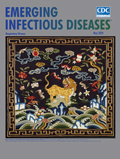
Blastomycosis is a systemic disease caused by Blastomyces spp. fungi. To determine its epidemiology in blastomycosis-endemic Minnesota, USA, we evaluated all cases reported to public health officials during 1999–2018. We focused on time to diagnosis, exposure activities, and exposure location. A total of 671 cases and a median of 34 cases/year were reported. Median time to diagnosis was 31 days; 61% of patients were not tested for blastomycosis until they were hospitalized. The case-fatality rate was 10%, and patients who died were 5.3 times more likely to have a concurrent medical condition. Outdoor activities and soil exposure were reported by many patients, but no specific activity or exposure was common to most. Almost one third of patients were probably exposed in geographic areas other than their home county. Providers should consider alternative etiologies for patients with pneumonia not responding to antibacterial treatment, and public health officials should increase awareness in blastomycosis-endemic areas.
| EID | Ireland M, Klumb C, Smith K, Scheftel J. Blastomycosis in Minnesota, USA, 1999–2018. Emerg Infect Dis. 2020;26(5):866-875. https://doi.org/10.3201/eid2605.191074 |
|---|---|
| AMA | Ireland M, Klumb C, Smith K, et al. Blastomycosis in Minnesota, USA, 1999–2018. Emerging Infectious Diseases. 2020;26(5):866-875. doi:10.3201/eid2605.191074. |
| APA | Ireland, M., Klumb, C., Smith, K., & Scheftel, J. (2020). Blastomycosis in Minnesota, USA, 1999–2018. Emerging Infectious Diseases, 26(5), 866-875. https://doi.org/10.3201/eid2605.191074. |
Invasive Cronobacter infections among infants are associated with severe neurologic disabilities and death. Early Cronobacter reports typically featured hospitalized and preterm infants and recognized contaminated powdered infant formula (PIF) as a transmission vehicle. To clarify recent epidemiology, we reviewed all cases of bloodstream infection or meningitis among infants that were reported to the Centers for Disease Control and Prevention and in the literature (1961–2018; n = 183). Most infants were neonates (100/150 [67%]); 38% (42/112) died, and 79% (81/102) had reported recent PIF consumption. In the final quarter of the study period (2004–2018), case counts were significantly higher (global average 8.7 cases/year); among US cases, significantly higher proportions occurred among full-term (56% [27/48]) and nonhospitalized (78% [42/54]) infants. PIF contamination, most commonly from opened containers, was identified in 30% (21/71) of investigations. Our findings reaffirm the need to promote safer alternatives for infant feeding, particularly among neonates.
| EID | Strysko J, Cope JR, Martin H, Tarr C, Hise K, Collier S, et al. Food Safety and Invasive Cronobacter Infections during Early Infancy, 1961–2018. Emerg Infect Dis. 2020;26(5):857-865. https://doi.org/10.3201/eid2605.190858 |
|---|---|
| AMA | Strysko J, Cope JR, Martin H, et al. Food Safety and Invasive Cronobacter Infections during Early Infancy, 1961–2018. Emerging Infectious Diseases. 2020;26(5):857-865. doi:10.3201/eid2605.190858. |
| APA | Strysko, J., Cope, J. R., Martin, H., Tarr, C., Hise, K., Collier, S....Bowen, A. (2020). Food Safety and Invasive Cronobacter Infections during Early Infancy, 1961–2018. Emerging Infectious Diseases, 26(5), 857-865. https://doi.org/10.3201/eid2605.190858. |
Volume 26, Number 4—April 2020
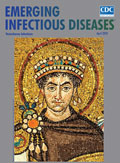
Tickborne diseases are rare in Washington, USA, and the ecology of these pathogens is poorly understood. We integrated surveillance data from humans and ticks to better describe their epidemiology and ecology. During 2011–2016, a total of 202 tickborne disease cases were reported in Washington residents. Of these, 68 (34%) were autochthonous, including cases of Lyme disease, Rocky Mountain spotted fever, tickborne relapsing fever, and tularemia. During May 2011–December 2016, we collected 977 host-seeking ticks, including Ixodes pacificus, I. angustus, I. spinipalpis, I. auritulus, Dermacentor andersoni, and D. variabilis ticks. The prevalence of Borrelia burgdorferi sensu stricto in I. pacificus ticks was 4.0%; of B. burgdorferi sensu lato, 3.8%; of B. miyamotoi, 4.4%; and of Anaplasma phagocytophilum, 1.9%. We did not detect Rickettsia rickettsii in either Dermacentor species. Case-patient histories and detection of pathogens in field-collected ticks indicate that several tickborne pathogens are endemic to Washington.
| EID | Dykstra EA, Oltean HN, Kangiser D, Marsden-Haug N, Rich SM, Xu G, et al. Ecology and Epidemiology of Tickborne Pathogens, Washington, USA, 2011–2016. Emerg Infect Dis. 2020;26(4):648-657. https://doi.org/10.3201/eid2604.191382 |
|---|---|
| AMA | Dykstra EA, Oltean HN, Kangiser D, et al. Ecology and Epidemiology of Tickborne Pathogens, Washington, USA, 2011–2016. Emerging Infectious Diseases. 2020;26(4):648-657. doi:10.3201/eid2604.191382. |
| APA | Dykstra, E. A., Oltean, H. N., Kangiser, D., Marsden-Haug, N., Rich, S. M., Xu, G....Eisen, R. J. (2020). Ecology and Epidemiology of Tickborne Pathogens, Washington, USA, 2011–2016. Emerging Infectious Diseases, 26(4), 648-657. https://doi.org/10.3201/eid2604.191382. |
Volume 26, Number 3—March 2020
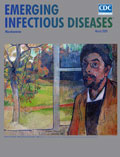
Recently, Tennessee, USA, has seen an increase in the use of commonly injected drugs, such as heroin and fentanyl. Injection drug use (IDU) practices can lead to life-threatening methicillin-resistant Staphylococcus aureus (MRSA) bloodstream infections (BSIs) and other serious diseases. We matched MRSA BSIs identified through the National Healthcare Safety Network to the Tennessee Hospital Discharge Data System to characterize the prevalence, demographics, and clinical characteristics associated with IDU in this disease population. Of the 7,646 MRSA BSIs identified during 2015–2017, we found that 1,839 (24.1%) were IDU-related. IDU-related BSIs increased by 118.9%; the greatest rise occurred among emergency department–onset infections (197.4%). IDU was more often associated with white, female, 18–49-year-old, and uninsured persons (p<0.001). We found >1 additional IDU-related diagnoses in 84.2% of IDU-related BSIs. Targeted harm reduction strategies for persons at high risk of IDU are necessary to reduce MRSA BSIs in acute care settings.
| EID | Parikh MP, Octaria R, Kainer MA. Methicillin-Resistant Staphylococcus aureus Bloodstream Infections and Injection Drug Use, Tennessee, USA, 2015–2017. Emerg Infect Dis. 2020;26(3):446-453. https://doi.org/10.3201/eid2603.191408 |
|---|---|
| AMA | Parikh MP, Octaria R, Kainer MA. Methicillin-Resistant Staphylococcus aureus Bloodstream Infections and Injection Drug Use, Tennessee, USA, 2015–2017. Emerging Infectious Diseases. 2020;26(3):446-453. doi:10.3201/eid2603.191408. |
| APA | Parikh, M. P., Octaria, R., & Kainer, M. A. (2020). Methicillin-Resistant Staphylococcus aureus Bloodstream Infections and Injection Drug Use, Tennessee, USA, 2015–2017. Emerging Infectious Diseases, 26(3), 446-453. https://doi.org/10.3201/eid2603.191408. |
Clinical characteristics of disseminated strongyloidiasis, the severest form of strongyloidiasis, are not well described. We conducted a retrospective, consecutive chart review of patients with disseminated strongyloidiasis admitted to Okinawa Chubu Hospital in Okinawa, Japan, during January 1975–December 2017. The 70 patients were classified into 3 clinical phenotypes: dissemination (32 patients [45.7%]), occult dissemination with meningitis caused by enteric organisms (12 patients [17.1%]), and occult dissemination with culture-negative suppurative meningitis (26 patients [37.1%]). Associated mortality rates were 56.3%, 16.7%, and 11.5%, respectively, and sepsis occurred in 40.6%, 58.3%, and 11.5% of cases, respectively. Common symptoms included fever (52.9% of patients), headache (32.9%), and altered mental status (24.3%). Patients were treated with thiabendazole (before 2003) or ivermectin (after 2003). Our findings show that disseminated strongyloidiasis has clinical phenotypes in terms of severity and that identification of occult dissemination, a mild form with prominent neurologic manifestations, is lifesaving.
| EID | Mukaigawara M, Narita M, Shiiki S, Takayama Y, Takakura S, Kishaba T. Clinical Characteristics of Disseminated Strongyloidiasis, Japan, 1975–2017. Emerg Infect Dis. 2020;26(3):401-408. https://doi.org/10.3201/eid2603.190571 |
|---|---|
| AMA | Mukaigawara M, Narita M, Shiiki S, et al. Clinical Characteristics of Disseminated Strongyloidiasis, Japan, 1975–2017. Emerging Infectious Diseases. 2020;26(3):401-408. doi:10.3201/eid2603.190571. |
| APA | Mukaigawara, M., Narita, M., Shiiki, S., Takayama, Y., Takakura, S., & Kishaba, T. (2020). Clinical Characteristics of Disseminated Strongyloidiasis, Japan, 1975–2017. Emerging Infectious Diseases, 26(3), 401-408. https://doi.org/10.3201/eid2603.190571. |
Cryptosporidiosis is a parasitic diarrheal infection that is transmitted by the fecal–oral route. We assessed trends in incidence and demographic characteristics for the 3,984 cases diagnosed during 1995–2018 in New York City, New York, USA, and reported to the New York City Department of Health and Mental Hygiene. Reported cryptosporidiosis incidence decreased with HIV/AIDS treatment rollout in the mid-1990s, but the introduction of syndromic multiplex diagnostic panels in 2015 led to a major increase in incidence and to a shift in the demographic profile of reported patients. Incidence was highest among men 20–59 years of age, who consistently represented most (54%) reported patients. In addition, 30% of interviewed patients reported recent international travel. The burden of cryptosporidiosis in New York City is probably highest among men who have sex with men. Prevention messaging is warranted for men who have sex with men and their healthcare providers, as well as for international travelers.
| EID | Alleyne L, Fitzhenry R, Mergen KA, Espina N, Amoroso E, Cimini D, et al. Epidemiology of Cryptosporidiosis, New York City, New York, USA, 1995–2018. Emerg Infect Dis. 2020;26(3):409-419. https://doi.org/10.3201/eid2603.190785 |
|---|---|
| AMA | Alleyne L, Fitzhenry R, Mergen KA, et al. Epidemiology of Cryptosporidiosis, New York City, New York, USA, 1995–2018. Emerging Infectious Diseases. 2020;26(3):409-419. doi:10.3201/eid2603.190785. |
| APA | Alleyne, L., Fitzhenry, R., Mergen, K. A., Espina, N., Amoroso, E., Cimini, D....Thompson, C. N. (2020). Epidemiology of Cryptosporidiosis, New York City, New York, USA, 1995–2018. Emerging Infectious Diseases, 26(3), 409-419. https://doi.org/10.3201/eid2603.190785. |
Volume 26, Number 2—February 2020
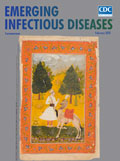
We conducted a recent investigation in Quebec, Canada, concerning Canadian deer hunters who went to the United States to hunt deer and returned with symptoms of fever, severe headache, myalgia, and articular pain of undetermined etiology. Further investigation identified that a group of 10 hunters from Quebec attended a hunting retreat in Illinois (USA) during November 22–December 4, 2018. Six of the 10 hunters had similar symptoms and illness onset dates. Serologic tests indicated a recent toxoplasmosis infection for all symptomatic hunters, and the risk factor identified was consumption of undercooked deer meat. Among asymptomatic hunters, 2 were already immune to toxoplasmosis, 1 was not immune, and the immune status of 1 remains unknown. Outbreaks of acute toxoplasmosis infection are rare in North America, but physicians should be aware that such outbreaks could become more common.
| EID | Gaulin C, Ramsay D, Thivierge K, Tataryn J, Courville A, Martin C, et al. Acute Toxoplasmosis among Canadian Deer Hunters Associated with Consumption of Undercooked Deer Meat Hunted in the United States. Emerg Infect Dis. 2020;26(2):199-205. https://doi.org/10.3201/eid2602.191218 |
|---|---|
| AMA | Gaulin C, Ramsay D, Thivierge K, et al. Acute Toxoplasmosis among Canadian Deer Hunters Associated with Consumption of Undercooked Deer Meat Hunted in the United States. Emerging Infectious Diseases. 2020;26(2):199-205. doi:10.3201/eid2602.191218. |
| APA | Gaulin, C., Ramsay, D., Thivierge, K., Tataryn, J., Courville, A., Martin, C....Dion, R. (2020). Acute Toxoplasmosis among Canadian Deer Hunters Associated with Consumption of Undercooked Deer Meat Hunted in the United States. Emerging Infectious Diseases, 26(2), 199-205. https://doi.org/10.3201/eid2602.191218. |
Observed peaks of acute flaccid myelitis (AFM) cases have occurred biennially since 2014 in the United States. We aimed to determine if AFM etiology differed between peak and nonpeak years, considering that clinical features of AFM differ by virus etiology. We compared clinical and laboratory characteristics of AFM cases that occurred during peak (2016 and 2018, n = 366) and nonpeak (2015 and 2017, n = 50) years. AFM patients in peak years were younger (5.2 years) than those in nonpeak years (8.3 years). A higher percentage of patients in peak years than nonpeak years had pleocytosis (86% vs. 60%), upper extremity involvement (33% vs. 16%), and an illness preceding limb weakness (90% vs. 62%) and were positive for enterovirus or rhinovirus RNA (38% vs. 16%). Enterovirus D68 infection was associated with AFM only in peak years. Our findings suggest AFM etiology differs between peak and nonpeak years.
| EID | McLaren N, Lopez A, Kidd S, Zhang JX, Nix W, Link-Gelles R, et al. Characteristics of Patients with Acute Flaccid Myelitis, United States, 2015–2018. Emerg Infect Dis. 2020;26(2):212-219. https://doi.org/10.3201/eid2602.191453 |
|---|---|
| AMA | McLaren N, Lopez A, Kidd S, et al. Characteristics of Patients with Acute Flaccid Myelitis, United States, 2015–2018. Emerging Infectious Diseases. 2020;26(2):212-219. doi:10.3201/eid2602.191453. |
| APA | McLaren, N., Lopez, A., Kidd, S., Zhang, J. X., Nix, W., Link-Gelles, R....Routh, J. A. (2020). Characteristics of Patients with Acute Flaccid Myelitis, United States, 2015–2018. Emerging Infectious Diseases, 26(2), 212-219. https://doi.org/10.3201/eid2602.191453. |
We conducted a retrospective cohort study to assess the effect of influenza virus type and subtype on disease severity among hospitalized influenza patients in Spain. We analyzed the cases of 8,985 laboratory-confirmed case-patients hospitalized for severe influenza by using data from a national surveillance system for the period 2010–2017. Hospitalized patients with influenza A(H1N1)pdm09 virus were significantly younger, more frequently had class III obesity, and had a higher risk for pneumonia or acute respiratory distress syndrome than patients infected with influenza A(H3N2) or B (p<0.05). Hospitalized patients with influenza A(H1N1)pdm09 also had a higher risk for intensive care unit admission, death, or both than patients with influenza A(H3N2) or B, independent of other factors. Determining the patterns of influenza-associated severity and how they might differ by virus type and subtype can help guide planning and implementation of adequate control and preventive measures during influenza epidemics.
| EID | Delgado-Sanz C, Mazagatos-Ateca C, Oliva J, Gherasim A, Larrauri A. Illness Severity in Hospitalized Influenza Patients by Virus Type and Subtype, Spain, 2010–2017. Emerg Infect Dis. 2020;26(2):220-228. https://doi.org/10.3201/eid2602.181732 |
|---|---|
| AMA | Delgado-Sanz C, Mazagatos-Ateca C, Oliva J, et al. Illness Severity in Hospitalized Influenza Patients by Virus Type and Subtype, Spain, 2010–2017. Emerging Infectious Diseases. 2020;26(2):220-228. doi:10.3201/eid2602.181732. |
| APA | Delgado-Sanz, C., Mazagatos-Ateca, C., Oliva, J., Gherasim, A., & Larrauri, A. (2020). Illness Severity in Hospitalized Influenza Patients by Virus Type and Subtype, Spain, 2010–2017. Emerging Infectious Diseases, 26(2), 220-228. https://doi.org/10.3201/eid2602.181732. |
Volume 26, Number 1—January 2020
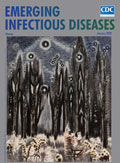
We assessed determinants of work attendance during the first 3 days after onset of acute respiratory illness (ARI) among workers 19–64 years of age who had medically attended ARI or influenza during the 2017–2018 influenza season. The total number of days worked included days worked at the usual workplace and days teleworked. Access to paid leave was associated with fewer days worked overall and at the usual workplace during illness. Participants who indicated that employees were discouraged from coming to work with influenza-like symptoms were less likely to attend their usual workplace. Compared with workers without a telework option, those with telework access worked more days during illness overall, but there was no difference in days worked at the usual workplace. Both paid leave benefits and business practices that actively encourage employees to stay home while sick are necessary to reduce the transmission of ARI and influenza in workplaces.
| EID | Ahmed F, Kim S, Nowalk M, King JP, VanWormer JJ, Gaglani M, et al. Paid Leave and Access to Telework as Work Attendance Determinants during Acute Respiratory Illness, United States, 2017–2018. Emerg Infect Dis. 2020;26(1):26-33. https://doi.org/10.3201/eid2601.190743 |
|---|---|
| AMA | Ahmed F, Kim S, Nowalk M, et al. Paid Leave and Access to Telework as Work Attendance Determinants during Acute Respiratory Illness, United States, 2017–2018. Emerging Infectious Diseases. 2020;26(1):26-33. doi:10.3201/eid2601.190743. |
| APA | Ahmed, F., Kim, S., Nowalk, M., King, J. P., VanWormer, J. J., Gaglani, M....Uzicanin, A. (2020). Paid Leave and Access to Telework as Work Attendance Determinants during Acute Respiratory Illness, United States, 2017–2018. Emerging Infectious Diseases, 26(1), 26-33. https://doi.org/10.3201/eid2601.190743. |
CME Articles by Volume

